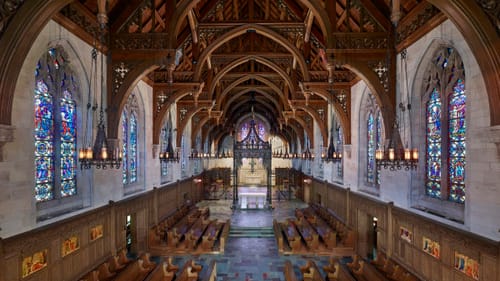Stay in the Loop
BSR publishes on a weekly schedule, with an email newsletter every Wednesday and Thursday morning. There’s no paywall, and subscribing is always free.
Going for Baroque
Princeton Festival presents Princeton Festival Baroque Chamber Ensemble

The Princeton Festival winds down after a successful 14th season, but for lovers of Baroque music, some of the best is saved for last. On June 23, 2018, members of the Princeton Festival Baroque Chamber Ensemble presented five examples of the dazzling universe of music composed in Western Europe in the 17th and 18th centuries. The concert was held in Princeton Abbey’s neo-Gothic chapel, a visual standout even among Princeton’s ubiquitous Gothic Revival architecture.
The program was enticing; no stale renditions of “Air on the G String” or “The Harmonious Blacksmith” here. Instead, concertmaster Juan Carlos Zamudio led five members of the ensemble in a program emphasizing the staggering variety of the Baroque experience, with an emotional range sure to startle casual listeners of music from this era.
A rushing tide of music
Zamudio led the program with “The Annunciation,” the first of the Rosary Sonatas by Heinrich Biber (1644-1704). Bohemian by birth, Biber composed and performed as a violinist throughout most of his career in Salzburg, Austria.
As violin soloist, Zamudio immediately set the tone, creating a large, dark sound, rising dramatically until it filled the entire holy space like the tide rushing in at Mont-Saint-Michel. Supported powerfully by the cello (Anna Steinhoff), theorbo (a bass lute played by Arash Noori), and harpsichord (Gregory Geehern), Zamudio launched into a series of breathtaking embellishments that sounded improvised. But I could see on his music stand the tumble of precise notes.
Ornamentation such as this is one of the miracles of Baroque music. There’s the melisma in which a single sung or played syllable spins out along several notes (think Handel’s Messiah or any pop star singing the National Anthem on opening day). There is the fioritura, long, convoluted ornaments that make me think of a liana vine’s curls and tendrils.
Biber’s Rosary Sonatas are fairly well known to chamber concertgoers. Not so, the program’s second work, the Trio Sonata in A Minor, Op. 4, No. 6, by Austro-Moravian violinist and composer Franz Xaver Richter (1709-1789).
Here, Zamudio was joined by violinist Maria Romero, with theorbo and harpsichord. I noticed a bit of the churchy sound inherent in playing in the Abbey, and it fit well since this replicated the atmosphere in which many of the era’s works were originally performed.
Zamudio and Romero brought a driven dynamic to the intense first movement, alternately hunching over their instruments and swinging back to let the music fly. After a light second movement, the passion returned in a third section with a conversation between both violinists whose lines echoed and mirrored each other.
The other other Bach
Halfway through this one-hour concert, it was time for Bach: Johann Bernhard Bach (1676-1749), the second cousin of Johann Sebastian, not to be confused with the nephew of the same name. For this Suite No. 3 in E Minor, the musicians were joined by a third violinist, Reynaldo Patino.

This is an enjoyable work with multiple movements (eight or nine, depending on the editor), each with a distinctive personality. The ensemble’s expressive richness and woodsy timbre shined throughout, including in sections featuring a playful trio, fugues, brilliant cello runs, and an assortment of embellishments served deliciously like musical tapas.
The program concluded with two spritely dance selections. The first was “Ballo detto Pollicio” by Tarquinio Merula (1595-1665), which moved without interruption into “Folias,” one of the biggest hits of the Baroque era, this version by Andrea Falconieri (1586-1656).
Theorbist Noori brought gypsy flair to the last selection, adding tapping and strumming to the classical techniques used to play this remarkable instrument. The work seemed to presage the "Fandango" from Boccherini’s Guitar Quintet, composed nearly two centuries later.
My only criticism is the inadequate printed program, which failed to alert us to the number of movements, the merging of the last two selections, and any valuable insights about the composers or performance history. I mentioned this in an earlier review at another venue, suggesting that program notes may be on their way out. I hope not.
The rumor that people no longer read is greatly exaggerated. Detailed program notes may add a few dollars to the production budget, but play an important role in increasing our appreciation and interest in great music. As an alternative or supplement, a few words by a performing artist between selections can’t hurt.
The Princeton Abbey was a wonderful venue for a small, short concert. Surrounded by gleaming stained glass, one felt cupped by the lusciousness of another time and place and reminded that music is part of the sacred.
There is still time to hear members of the Princeton Festival Baroque Orchestra (slightly different title and musical forces) perform other works this week. Juan Carlos Zamudio will lead the orchestra at 7:30 p.m. Wednesday, June 27, in Miller Chapel, Princeton Theological Seminary. Gregory Geehern (harpsichordist at this weekend’s program) will conduct the festival’s Baroque Chorus and Orchestra at 7 p.m. Saturday, June 30, also at Miller Chapel. For details, visit PrincetonFestival.org.
What, When, Where
Princeton Festival Baroque Orchestra's Chamber Ensemble. Conducted by Juan Carlos Zamudio. "The Annunciation," from the Rosary Sonatas, by Heinrich Biber; Trio Sonata in A minor Op. 4, No. 6, by François Xaver Richter; Suite in E minor, by Johann Bernhard Bach; "Ballo detto Pollicio," by Tarquinio Merula; "Folias," by Andrea Falconieri. Saturday, June 23, 2018, Princeton Abbey, 75 Mapleton Road, Princeton, New Jersey. (609) 258-2787 or PrincetonFestival.org.
Sign up for our newsletter
All of the week's new articles, all in one place. Sign up for the free weekly BSR newsletters, and don't miss a conversation.

 Linda Holt
Linda Holt